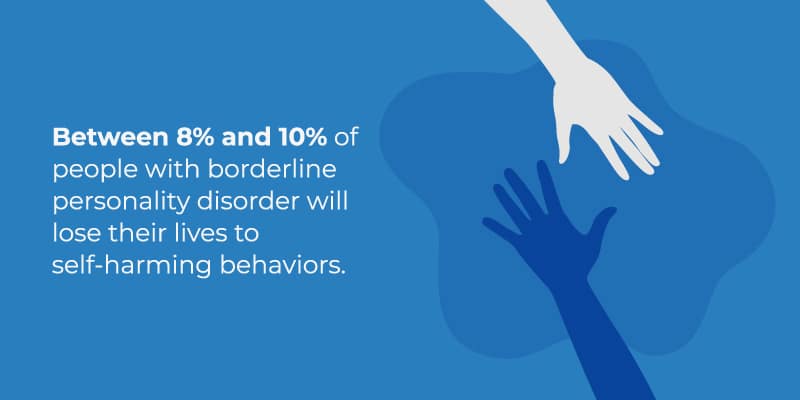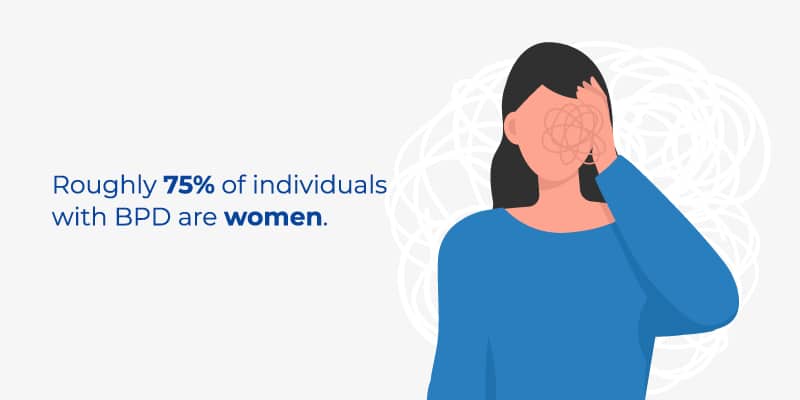

Borderline Personality Disorder Diagnosis and Treatment
Learn more about borderline personality disorder and its causes, symptoms, and treatments here.
Table of Contents
Reach Out to Learn More
Introduction to Borderline Personality Disorder (BPD)
Living with borderline personality disorder may lead to significant challenges in regulating emotions. Someone with BPD may be impulsive and experience difficulty in their relationships. Some may view themselves in a negative light or feel poorly about their personality, image, or behaviors.

Characteristics of BPD
- Frequent mood changes
- Anger
- Aggression
- Antisocial behavior
- Impulsive behavior
- Self-destructive behavior
- Chronic feelings of emptiness
What is BPD? A Closer Look
Understanding Borderline Personality Disorder
When it comes to mental health, feeling good about yourself and your relationships is important. Unfortunately, that’s sometimes easier said than done. For people who have borderline personality disorder, this can be incredibly difficult.
What is Borderline Personality Disorder?
Borderline personality disorder isn’t to be confused with bipolar disorder, though the abbreviation is the same.
How Common is BPD?
Of these diagnosed individuals, roughly 75% are women. However, it’s now believed that men may be suffering from BPD more often than was thought. The belief is that they’ve been misdiagnosed with PTSD or a depressive disorder instead of BPD.
What Does it Feel Like to Have BPD?
Important Note About Co-Occurring Conditions
- Major depressive disorder
- Post-traumatic stress disorder (PTSD)
- Anxiety disorders
- Bipolar disorder
- Eating disorders
- Substance use disorders

Causes and Risk Factors of BPD
There isn’t a pinpointed cause for borderline personality disorder at this point. However, some of the common risk factors that may point to BPD include:5
Genetics
- Mother
- Father
- Sister
- Brother
Environmental Factors
- Sexual abuse
- Emotional abuse
- Physical abuse
- Parental neglect or mistreatment
Brain Abnormalities
Traumatic or Stressful Life Events
Adults who experience significant stress or trauma during childhood are at a greater risk for developing BPD.
For example, children raised in unstable environments, such as living with a parent with a substance use disorder, or a child who experienced parental loss, may be more likely to develop BPD.
Some researchers suggest BPD symptoms may evolve from coping strategies developed during youth.7
Signs and Symptoms of BPD
Unstable Relationships
Impulsive, Self-Destructive Behaviors
- Gambling
- Reckless driving
- Unsafe sex
- Spending sprees
- Binge eating
- Drug abuse
- Sabotaging success
- Ending positive relationships
- Self-injury
- Suicidal thoughts/threats
Chronic Feelings of Emptiness, Loneliness, and Depression
Shifting Feelings
Stress-Related Paranoia
Mood Swings
- Happiness
- Depression
- Irritability
- Anxiety
- Shame
How Do Mental Health Professionals Diagnose BPD?
Interview
Psychological Evaluation
Medical History and Exam
Discussing Signs and Symptoms
Evaluation of Family History
“Living MRI” Comprehensive Evaluation
J. Flowers Health Institute provides our “Living MRI” which offers specific tests and exams with our medical professionals that will be personalized to your needs.
- Medical evaluation
- Psychological and psychiatric evaluation
- Substance use disorder testing
- Lifestyle assessment
- Trauma assessments
Diagnosing Borderline Personality Disorder in Youth

Borderline Personality Disorder Treatments
The primary treatment model used in BPD treatment is psychotherapy. In some instances, medications may help to limit the impact of certain symptoms. A mental health provider may also recommend short-term hospitalization before therapeutic treatment if a person’s health or safety is at risk.
Psychotherapy
Psychotherapy is also referred to as talk therapy. It’s a primary therapeutic model for BPD treatment.
- Teaching patients how to manage and cope with uncomfortable emotions
- Learning how to observe and sit with feelings rather than act on them
- Working on improving and healing relationships by learning to be aware of the feelings of others (as well as the person’s own emotions)
- Learning more about borderline personality disorder
- Focusing on improving function and reducing impulsivity
Dialectical Behavior Therapy (DBT)
DBT attempts to identify and change negative thinking patterns and pushes for positive behavioral changes.
What is DBT?
Schema-Focused Therapy
Mentalization-Based Therapy (MBT)
MBT is an analysis of mental states and their underlying causes.
Systems Training for Emotional Predictability and Problem-Solving (STEPPS)
STEPPS is a 20-week program that combines skills training and cognitive-behavioral therapy.
Transference-Focused Psychotherapy (TFP)
TFP includes twice-weekly therapy sessions that help stress the importance of social interactions in changing maladaptive behavior.
Good Psychiatric Management
- Family education
- Individual sessions
- Group therapy
- Medications
Importance of Therapeutic Relationships
BPD Medications
- Anxiety
- Impulsive behavior
- Depression
- Aggression
Important Note About Medications
Hospitalization
Should the symptoms of BPD become a danger for the person suffering from the disorder, inpatient hospitalization may be needed.
This is to help the person avoid self-harm or possibly harming others while getting them started on the psychotherapy they need to begin recovery.
Coping With Borderline Personality Disorder
Calm the Emotional Storm
Learn to Control Impulsivity and Tolerate Distress
Engaging in less harmful behaviors can lead to better relationships, reducing the amount of stress you experience.
Improve Your Interpersonal Skills
Don’t Make Assumptions
Keep Up a Healthy Lifestyle

Getting Treatment for BPD at J. Flowers Health Institute
Remaining engaged and active in your treatment program can help improve your ability to function and improve your self-esteem and the quality of your relationships.
Contact J. Flowers Health Today
If you or a loved one live with borderline personality disorder and would like to learn more about how J. Flowers Health Institute can help, contact us today.
Resources
- https://www.mayoclinic.org/diseases-conditions/borderline-personality-disorder/symptoms-causes/syc-20370237
- https://www.nami.org/About-Mental-Illness/Mental-Health-Conditions/Borderline-Personality-Disorder
- https://www.sciencedirect.com/science/article/abs/pii/S0006322306011929
- https://www.nimh.nih.gov/health/topics/borderline-personality-disorder#:~:text=How%20is%20borderline%20personality%20disorder,experiences%2C%20and%20family%20medical%20history
- https://my.clevelandclinic.org/health/diseases/9762-borderline-personality-disorder-bpd
- https://www.ncbi.nlm.nih.gov/pmc/articles/PMC1863557/
- https://www.hopkinsmedicine.org/health/conditions-and-diseases/borderline-personality-disorder
- https://psychiatryonline.org/pb/assets/raw/sitewide/practice_guidelines/guidelines/bpd.pdf





